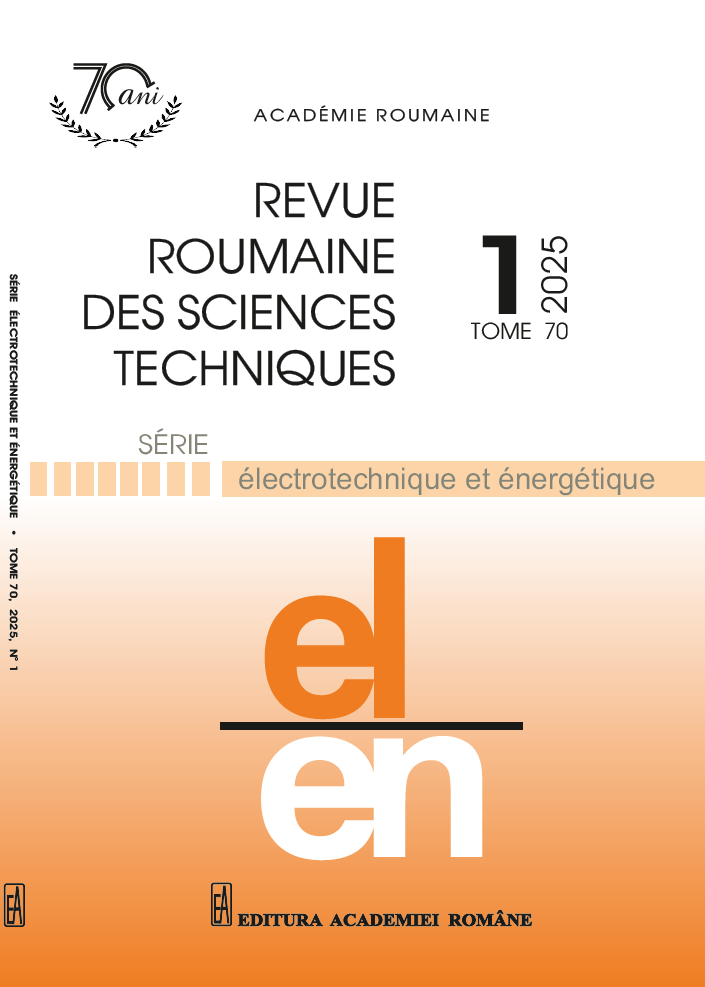PRÉDICTION DE LA PROCHAINE POSITION PAR APPRENTISSAGE PROFOND, COMPRESSION ET EXCITATION, UNITÉ RÉCURRENTE BIDIRECTIONNELLE À PORTÉE
DOI :
https://doi.org/10.59277/RRST-EE.2025.1.20Mots-clés :
Apprentissage profond, Prédiction de la prochaine position, Compression et excitation, PrécisionRésumé
La prédiction de la prochaine position a récemment suscité un vif intérêt de la part des chercheurs en raison de ses applications dans divers domaines. De nombreuses variables influencent généralement la trajectoire des objets en mouvement, notamment le temps, la distance et la configuration de l'utilisateur. Il est donc difficile de prédire la destination des objets en mouvement lorsque ces facteurs sont pris en compte. Cette recherche propose un réseau de prédiction de la prochaine position basé sur l'apprentissage profond (DL-NLocP) afin d'améliorer la précision de la prédiction de la prochaine position. Dans un premier temps, les jeux de données sont prétraités afin d'améliorer la qualité des données et utilisent des approches de type « term frequency-inverse document frequency » (TF-IDF) avec des approches d'intégration de mots clés pour convertir les données textuelles en vecteurs à valeurs réelles. Ensuite, un CNN multi-têtes extrait les caractéristiques temporelles, de localisation et de comportement de l'utilisateur des données vectorielles. Enfin, la compression et l'excitation avec le réseau BiGRU sont développées pour prédire la prochaine position sur chaque trajectoire avec des informations contextuelles. Le modèle DL-NLPN proposé a été testé sur les jeux de données Ningbo AIS et Geolife, et les résultats expérimentaux ont confirmé sa validité. Le modèle proposé surpasse systématiquement les approches de pointe actuelles de 93,75 % pour Geolife et de 94,75 % pour Ningbo AIS en termes de précision moyenne à 20. Les résultats montrent que l'approche proposée est plus performante dans la prédiction de la prochaine localisation que les méthodes existantes.
Références
(1) Y. Xiao, Q. Nian, Vehicle location prediction based on spatiotemporal feature transformation and hybrid LSTM neural network, Information, 11, 2, pp. 84 (2020).
(2) J.P. Singh, Y.K. Dwivedi, N.P. Rana, A. Kumar, K.K. Kapoor, Event classification and location prediction from tweets during disasters, Annals of Operations Research, 283, pp.737-757 (2019).
(3) D. Yao, C. Zhang, J. Huang, J. Bi, Serm: A recurrent model for next location prediction in semantic trajectories, ACM on Conference on Information and Knowledge Management, pp. 2411-2414 (2017).
(4) S. Kumar, M.I. Nezhurina, An ensemble classification approach for prediction of user’s next location based on Twitter data, Journal of Ambient Intelligence and Humanized Computing, 10, pp.4503-4513 (2019).
(5) K.R. Seelam, V.A. Reddy, N. Arpitha, Location prediction on Twitter using machine learning, Journal of Engineering Sciences, 14, 01 (2023).
(6) H. Li, B. Wang, F. Xia, X. Zhai, S. Zhu, Y. Xu, PG^2 Net: personalized and group preferences guided network for next place prediction (2021).
(7) P.J. Shermila, A. Ahilan, A.J.G. Malar, R. Jothin, MDEEPFIC: food item classification with calorie calculation using modified dragon fly deep learning network., Journal of Intelligent & Fuzzy Systems, (Preprint), pp.1-12.
(8) J. Lv, Q. Sun, Q. Li, L. Moreira-Matias, Multi-scale and multi-scope convolutional neural networks for destination prediction of trajectories, IEEE Transactions on Intelligent Transportation Systems, 21, 8, pp.3184-3195 (2019).
(9) A. Agasthian, Rajendra Pamula, L.A. Kumaraswamidhas, Integration of monitoring and security based deep learning network for wind turbine system, International Journal of System Design and Computing, 1, 1, pp. 11-17, (2023).
(10) M. Luca, L. Pappalardo, B. Lepri, G. Barlacchi, Trajectory test-train overlap in next-location prediction datasets, Machine Learning, pp.1-38 (2023).
(11) A. Sassi, M. Brahimi, W. Bechkit, A. Bachir, Location embedding and deep convolutional neural networks for next location prediction. IEEE 44th LCN symposium on emerging topics in networking (LCN symposium), IEEE. pp. 149-157 (2019).
(12) R. Zhang, J. Guo, H. Jiang, P. Xie, C. Wang, Multi-task learning for location prediction with deep multi-model ensembles, IEEE 21st International Conference on High-Performance Computing and Communications; IEEE 17th International Conference on Smart City; IEEE 5th International Conference on Data Science and Systems (HPCC/SmartCity/DSS), pp. 1093-1100 (2019).
(13) T. Qian, F. Wang, Y. Xu, Y. Jiang, T. Sun, Y. Yu, CABIN: a novel cooperative attention based location prediction network using internal-external trajectory dependencies: Springer International Publishing, pp. 521-532 (2020).
(14) X. Zhang, B. Li, C. Song, Z. Huang, Y. Li, SASRM: a semantic and attention spatio-temporal recurrent model for next location prediction. International Joint Conference on Neural Networks (IJCNN) IEEE. pp. 1-8 (2020).
(15) S. Wang, A. Li, S. Xie, W. Li, B. Wang, S. Yao, M. Asif, A spatial-temporal self-attention network (STSAN) for location prediction. Complexity, pp.1-13 (2021).
(16) N. Rathore, N.L. Panwar, F. Yettou, A. Gama, Estimation and mapping of linke turbidity factor from solar radiation measurement for Indian climatic conditions, Revue Roumaine Des Sciences Techniques—Série Électrotechnique Et Énergétique, 66, 4, pp. 285-294 (2021).
(17) Dobre, A.M. Ilie-Sandoiu, A.M. Morega, E. Gheorghiu, Magnetic field control in an analytic platform for assessment of pathogenic bacteria, Revue Roumaine Des Sciences Techniques—Série Électrotechnique Et Énergétique, 68, 3, pp. 317-322 (2023).
Téléchargements
Publiée
Numéro
Rubrique
Licence
(c) Copyright REVUE ROUMAINE DES SCIENCES TECHNIQUES — SÉRIE ÉLECTROTECHNIQUE ET ÉNERGÉTIQUE 2025

Ce travail est disponible sous licence Creative Commons Attribution - Pas d'Utilisation Commerciale - Pas de Modification 4.0 International.


